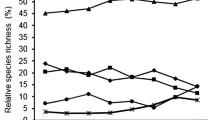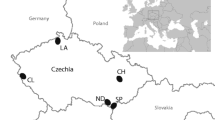Summary
The five most abundant species were included in a year-round study with respect to six foraging niche dimensions. Approximately full multidimensional utilization functions were used for niche metrics. During summer foraging overlaps were invariably high, but in other seasons periodically lower. Foraging site breadth was lower in winter, when fewer sites are profitable for foraging than in summer. Feeding posture versatility, by contrast, was highest in winter. Seasonal foraging shifts were very prominent, as great in fact as between-species differences. Often seasonal trends were parallel in different species. Niche axes of macrohabitat-type (e.g. tree) were more open for foraging variation and axes of microhabitat-type (tree part) more rigid. Among the resident species seasonal variation in foraging was greatest in Regulus regulus and Parus cristatus, whereas the foraging behaviour was more stable for P. montanus (an abundant species with broad niche), perhaps owing to greater intraspecific competition. In these northern forests foliage-gleaners must be versatile generalists to cope with the unpredictable resources, and thus they overlap broadly in their general resource niches which are determined by their genetically fixed cost and benefit relations to each resource type. Anyhow, presumably during periodical food shortage, the actual resource uses adjusted by resource availability and competition may overlap narrowly.
Similar content being viewed by others
References
Alatalo, R.H., Alatalo, R.V.: Estimation of genetic variation by the components of gene diversity. Aquilo Ser. Zool. (in press)
Alatalo, R.V.: Bird community energetics in a boreal coniferous forest. Holarct. Ecol. 1, 367–376 (1978)
Alatalo, R.V., Alatalo, R.H.: Components of diversity: multivariate analysis with interaction. Ecology 58, 900–906 (1977)
Alatalo, R.V., Alatalo, R.H.: Resource partitioning among a fly, catcher guild in Finland. Oikos 33, 46–54 (1979)
Baker, M.C., Baker, A.E.M.: Niche relationships among six species of shorebirds on their wintering and breeding ranges. Ecol. Monogr. 43, 193–212 (1973)
Betts, M.M.: The food of titmice in oak woodland. J. anim. Ecol. 24, 282–323 (1955)
Feinsinger, P.: Organization of a tropical guild of nectarivorous birds. Ecol. Monogr. 46, 257–291 (1976)
Fretwell, S.D.: Populations in a seasonal environment. Princeton: Princeton Univ. Press 1972
Gibb, J.: Feeding ecology of tits, with notes on Treecreeper and Goldcrest. Ibis 96, 513–543 (1954)
Gibb, J.: Populations of tits and Goldcrests and their food supply in pine plantations. Ibis 102, 163–208 (1960)
Gibb, J., Betts, M.M.: Food and food supply of nestling tits Paridae in Breckland pine. J. anim. Ecol. 32, 489–533 (1963)
Haftorn, S.: Contribution to the food biology of tits, especially about storing of surplus food. Part IV. Kgl. Norsk. Vid. Selsk. Skr. No. 4, 1–54 (1956)
Hartley, P.H.T.: An ecological study of the feeding habits of the English titmice. J. anim. Ecol. 22, 263–288 (1953)
Hespenheide, H.A.: Prey characteristics and predator niche width. In: Ecology and evolution of communities (M.L. Cody, J.M. Diamond, eds.), pp. 158–180. Cambridge, Massachusetts: Belknap Press of Harvard Univ. Press 1975
Hurlbert, S.H.: The measurement of niche overlap and some relatives. Ecology 59, 67–77 (1978)
Hutchinson, G.E.: Concluding remarks. Cold Spring Harbour Symp., Quant. Biol. 22, 415–427 (1957)
Lack, D.: The natural regulation of animal populations. London: Oxford Univ. Press 1954
Lack, D.: Ecological isolation in birds. Oxford-Edinburgh: Black-well 1971
Laursen, K.: Interspecific relationships between some insectivorous passerine species, illustrated by their diet during spring migration. Ornis Scandinavica 9, 178–192 (1978)
MacArthur, R.H.: Geographical ecology New York: Harper and Row 1972
May, R.M.: Some notes on estimating the competition matrix, α. Ecology 56, 737–741 (1975)
Miller, R.S.: Patterns and process in competition. Adv. Ecol. Res. 4, 1–74 (1967)
Morse, D.H.: The insectivourous bird as an adaptive strategy. Ann. Rev. Ecol. Syst. 2, 177–200 (1971)
Newton, I.: The adaptive radiation and feeding ecology of some British finches. Ibis 109, 33–98 (1967)
Opdam, P.: Inter- and intraspecific differentiation with respect to feeding ecology in two sympatric species of the genus Accipiter. Ardea 63, 30–54 (1975)
Partridge, L.: Individual differences in feeding efficiencies and feeding preferences of captive Great Tits. Anim. Behav. 24, 230–240 (1976)
Pianka, E.R.: Competition and niche theory. In: Theoretical ecology: Principles and applications (R.M. May, ed.), pp. 114–141. Oxford: Blackwell 1976
Pyke, G.H., Pulliam, H.R., Charnov, E.L.: Optimal foraging: a selective review of theory and tests. Q. Rev. Biol. 52, 137–154 (1977)
Rabenold, K.N.: Foraging strategies, diversity, and seasonality in bird communities of Appalachian spruce-fir forests. Ecol. Monogr. 48, 397–424 (1978)
Rabenold, K.N.: A reversed latitudinal gradient in avian communities of eastern deciduous forest. Am. Nat. 114, 275–286 (1979)
Roughgarden, J.: Resource partitioning among competing species — a coevolutionary approach. Theor. Pop. Biol. 9, 388–424 (1976)
Schoener, T.W.: Some methods for calculating competition coefficients from resource-utilization spectra. Am. Nat. 108, 332–340 (1974)
Smith, J.N.M., Grant, P.R., Grant, B.R., Abbott, I.J., Abbott, L.K.: Seasonal variation in feeding habits of Darwin's ground finches. Ecology 59, 1137–1150 (1978)
Stallcup, P.L.: Spatio-temporal relationships of nuthatches and woodpeckers in Ponderosa pine forest of Colorado. Ecology 49, 831–843 (1968)
Tinbergen, L.: The natural control of insects in pine woods. I. Factors influencing the intensity of predation by songbirds. Arch. Neerl. Zool. 13, 265–343 (1960)
Ulfstrand, S.: Feeding niches of some passerine birds in a south Swedish coniferous plantation in winter and summer. Ornis Scandinavica 7, 21–27 (1976)
Ulfstrand, S.: Foraging niche dynamics and overlap in a guild of passerine birds in a south Swedish coniferous woodland. Oecologia (Berl.) 27, 23–45 (1977)
Vandermeer, J.H.: Niche theory. Ann. Rev. Ecol. Syst. 3, 107–132 (1972)
Wiens, J.A.: On competition and variable environments. Amer. Sci. 65, 590–597 (1977)
Wilson, D.S.: Deducing the energy available in the environment: an application of optimal foraging theory. Biotropica 8, 96–103 (1976)
Author information
Authors and Affiliations
Rights and permissions
About this article
Cite this article
Alatalo, R.V. Seasonal dynamics of resource partitioning among foliage-gleaning passerines in northern Finland. Oecologia 45, 190–196 (1980). https://doi.org/10.1007/BF00346459
Received:
Issue Date:
DOI: https://doi.org/10.1007/BF00346459




